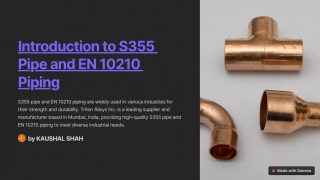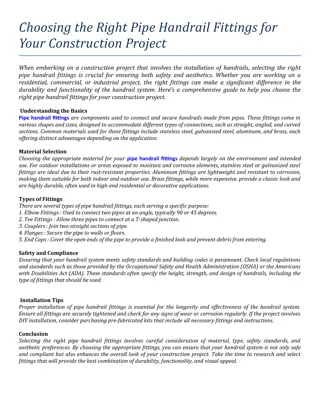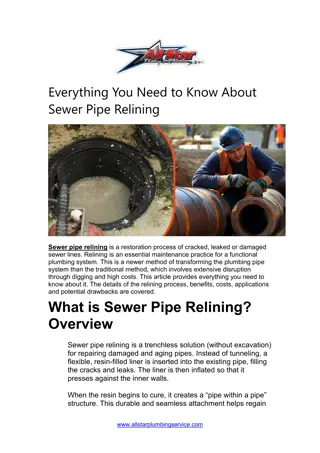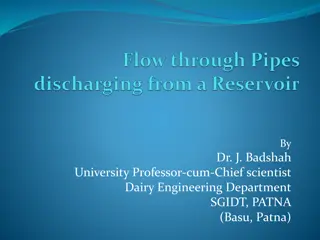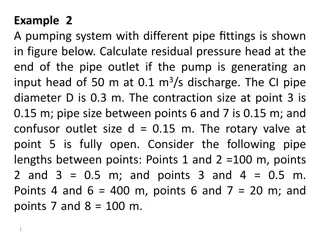Math for Grades 1 and 2: Area Calculations in Pipe Systems
Learn how to calculate the area of a circle, convert measurements from inches to feet, and solve practical problems related to pipe systems. Discover the formulas and methods for finding area and volume in this informative guide.
Download Presentation

Please find below an Image/Link to download the presentation.
The content on the website is provided AS IS for your information and personal use only. It may not be sold, licensed, or shared on other websites without obtaining consent from the author.If you encounter any issues during the download, it is possible that the publisher has removed the file from their server.
You are allowed to download the files provided on this website for personal or commercial use, subject to the condition that they are used lawfully. All files are the property of their respective owners.
The content on the website is provided AS IS for your information and personal use only. It may not be sold, licensed, or shared on other websites without obtaining consent from the author.
E N D
Presentation Transcript
CWEA COLLECTION SYSTEM OPERATOR CERTIFICATION MATH FOR GRADES 1 AND 2
FINDING THE AREA OF A CIRCLE When finding the area of a circle you need to take the diameter of the circle and times it by it self, and then multiply by .785 .785 is a constant when dealing with diameter of a circular pipe.
TO FIND THE AREA YOU MUST CHANGE INCEHS INTO FEET SEE EXAMPLE BELOW Take the inches that you need to change and divide them by 12 There is 12 inches in a foot Example: 6 /12 = .5 Example: 8 /12 = .6666666667 if this happens, round up to the next number after three spots. example..6666666667 would be .667
Example conversion Example: What is the diameter of a 6 pipe? 6 /12 = 5 , so you take .5 X .5 X .785= 0.19625 or round up to 0.196 Diameter is from one side of the circle to the other side. .785 is for the missing corners
QUESTION # 6 The interior of 300 feet of 12- inch pipe is uniformly coated with one inch of grease. How many gallons will this pipe hold when filled with water?
QUESTION # 6 12 pipe uniformly coated with 1 of grease. What is the true diameter of the opening? 12 10
QUESTION # 6 10 /12 = .833 .833 X .833 X .785 = .545sq. X 300 =163.41cu. 163.41cu. x 7.48gals/cu. = 1,222.3gals.
ANSWER TO QUESTION #6 1,222 GALLONS
QUESTION #12 A flow of 650 gpm would be how many mgd?
CONVERTING TIME TO CHANGE DAYS INTO HOURS: TAKE THE DAYS THAT YOU HAVE AND MULTIPLY BY 24/HRS. IN A DAY TO CHANGES HRS. TO MINUTES: TAKE THE HRS. THAT YOU HAVE AND MULTIPLY BY 60/MIN. IN A HOUR. TO CHANGES MINUTES INTO SECONDS: TAKE THE MIN. THAT YOU HAVE AND MULTIPLY BY 60/SEC. IN A MIN.
QUESTION # 12 Take 650 gpm X 1440 min./day = ? (650gpm X 1440mpd =) Min. cancel min. leaving you with 650 gals. X 1440 day = 936,000 gpd. But they want this in million gallons/day. Take 936,000 gpd and divide (/) by 1,000,000 = .936mgd
ANSWER TO QUESTION # 12 0.936mgd
QUESTION # 14 If it takes 7 minutes and 30 seconds for dye to travel a distance of 860 feet through an eight inch sewer, what is the velocity in fps?
QUESTION # 14 Need to change minutes into seconds Take 7min X60spm = 420sec + 30sec = 450sec Take the 860 / 420sec = 1.91fps
ANSWER TO QUESTION # 14 1.91fps
Question #16 You receive a dispatch at 4:30 P.M. informing you that raw sewage is spewing out of a manhole onto the ground and into a small stream adjacent to a sparsely populated neighborhood. The caller reporting the problem indicated that it had been spilling sewage since 2P.M. and that she noticed it while driving by on the 405 freeway stuck in stop and go traffic. She indicated that she was not able to call right away and report the spill because of restrictions on using cell phone when driving a motor vehicle. You immediately dispatch a hydo-vac crew to the site to assist you in taking care of the problem. Upon arrival at the manhole at 5:15P.M., you notice right away the sewage is spilling out from around an unsecured 24-inch bolt down manhole cover. You field measure the height of the sewage from the top of the frame. Based on current engineered SSO volume estimation, a sewage spout 5 inches above a manhole rim with culver still in place tabulates out to 166 gallons per minute. You also notice that the SSO is flowing from between the manhole and the creek. As the creek was flowing rather high that afternoon after an earlier rainstorm, none of the spill would be recoverable. Your crews had setup their equipment and were able to clear the problem causing the mainline stoppage 22 minutes after your arrival. Based on the information supplied, how many reportable unrecoverable gallons of raw sewage had reached the creek?
QUESTION # 16 Estimate spill time Convert into minutes Estimate amount of the spill in gallons per minute Multiply the spill time by the gallons per minute Equals answer
QUESTION # 16 Caller indicated that she notice the spill at 2P.M. (You receive a dispatch at 4:30 P.M. The caller reporting the problem indicated that it had been spilling sewage since 2P.M.) You arrive at 5:15P.M. Crew clear the problem in 22 minutes. What is your total time
QUESTION # 16 Subtract 2P.M. from 5:15P.M. = 3hrs 15min Turn 3 hrs into minutes by multiplying by 60mph ( 3hrs X 60 mph = 180min ) Add the 15 min onto the 180 min ( 15min + 180 min = 195 min )
QUESTION # 16 Crew time of 22min add to 195min you have = 22min + 195min = 217min
QUESTION # 16 166 gallons per minute.
QUESTION # 16 166 gpm X 217 min =
QUESTION # 16 ANSWER 36,022 gallons
LETS REVIEW
HOW TO CHANGE INCHES INTO FEET Take the inches that you need to change and divide them by 12 There is 12 inches in a foot Example: 6 /12 = .5 Example: 8 /12 = .6666666667 if this happens, round up to the next number after three spots. example..6666666667 would be .667
FINDING THE AREA OF A CIRCLE When finding the area of a circle you need to take the diameter of the circle and times it by it self, and then multiply by .785 Example: What is the diameter of a 6 pipe? 6 =.5 , so you take .5 X .5 X .785= 0.19625 or round up to 0.196 Diameter is from one side of the circle to the other side.
CONVERTING TIME TO CHANGE DAYS INTO HOURS: TAKE THE DAYS THAT YOU HAVE AND MULTIPLY BY 24/HRS. IN A DAY TO CHANGES HRS. TO MINUTES: TAKE THE HRS. THAT YOU HAVE AND MULTIPLY BY 60/MIN. IN A HOUR. TO CHANGES MINUTES INTO SECONDS: TAKE THE MIN. THAT YOU HAVE AND MULTIPLY BY 60/SEC. IN A MIN.
EXAMPLE 3days X 24hrs/day = ? Days cancel days (3days X 24hpd) leaving you with 3 X 24hrs = 72hrs. 24hrs /day X 60min / hrs =? Hrs. cancel hrs. (24hpd X 60mph) leaving you with 24/day X 60 min = 1,440 mpd (minute per day) 1440mpd X 60spm = ? Min. cancel min. (1440mpd X 60spm) leaving you with 1440/day X 60sec.=86,400 spd. (second per day)
QUESTION # 42 If a 6 force main has a metered flow of 200,000gpd, what is the velocity?
FLOW FORMULA Q = Flow (Quantity) (gpd, gpm, gps) V = Velocity (fps) A = Area (sq. ft.) Q = A x V V = Q/A A = Q/V
QUESTION # 42 6in/12inf = 0.5ft 0.5X0.5X0.785= 0.196sq.ft. (area) 200,000gpd/1440mpd=138.889gpm (needs to be in seconds) 138.889gpm/60spm=2.315gps
QUESTION # 42 6in/12inf = 0.5ft. 0.5X0.5X0.785= 0.196sq.ft. (area) 200,000gpd/1440mpd=138.889gpm (needs to be in seconds) 138.889gpm/60spm=2.315gps 2.315gps/7.48gcf= 0.309cfs 0.309cfs/0.196sq.ft.=1.58fps
QUESTION # 42 ANSWER 1.6FPS (actual answer is 1.58)
QUESTION # 43 Wastewater is pumped through an 8 force main @ the rate of 425gpm. What is the velocity?
QUESTION # 43 8in/12inf = 0.667 0.667 X0.667 X.785=0.349sqf 425gpm / 60spm = 7.08gps 7.08gps / 7.48gcuf = 0.946cfs 0.946cfs/0.349sqf = 2.71fps
QUESTION # 43 ANSWER 2.7FPS (actual answer 2.712 round down)
QUESTION # 44 An 8 pipe serves 1,837 homes with 2.6 people per home using 100 gallons of water each day. What is the velocity in fps?
QUESTION # 44 8 inches / ??? ?? ????= 0.667 feet 0.667 X0.667 X 0.785 = 0.349sqft
QUESTION # 44 1,837 homes X 100???????/??? = 183,700??????? ??? ??? 183,700gpd / 1440mpd = 127.569gpm 127.569gpm / 60spm = 2.126gps
QUESTION # 44 Need to change the 2.126gps into feet per second 2.126??????? ??????/ 7.48 ??????? ??.????= 0.284????? ???? ?????? 0.284????? ???? / 0.349sqft = 0.813???? ?????? ?????
QUESTION # 44 ANSWER 0.81fps
CWEA COLLECTION SYSTEM OPERATOR CERTIFICATION MATH FOR GRADES 3 AND 4
QUESTION # 1 A pump station has three constant speed pumps with a field measure horsepower of the pumps of 73 (pump #1), 78 (pump #2) and 71 ( pump #3). By changing to new, more efficient pumps, the horsepower can be reduced to 65 horsepower per pump and maintain the same flow rate. Total cost of conversion: $64,000.00 Power costs $0.63 cent/KwH pump station Average flow 10.5mgd Hour Meter Reading Beginning of Year End of Year Pump 1 110,356 115,293 Pump 2 24,224 25,031 Pump 3 38,331 39,622 Given the information above, determine the annual saving in dollars, if new pumps are installed:
QUESTION # 1 Determined the different in horsepower between the old pumps and the new pumps old Pump # 1 73hp - 65hp = 8hp Pump # 2 78hp - 65hp = 13hp Pump # 3 71hp - 65hp = 6hp new difference
QUESTION # 1 Change the horsepower of the pumps into kilowatts (one horsepower = .746kw) 8hp X .746?? Pump #1 = 5.968kw 1 ? 13hp X .746?? Pump # 2 = 9.698kw 1 ? Pump # 3 6hp X .746?? = 4.476kw 1 ?
QUESTION # 1 Change the kilowatts of the pumps to cost per hour per pump ($0.63cent/Kw Hours) 5.968kw X $0.63?? Pump # 1 1 ???= $3.76/hour Pump # 2 9.698kw X $0.63?? 1 ???= $6.11/hour Pump # 3 4.476kw X $0.63?? 1 ???= $2.82/hour
QUESTION # 1 Determine the annual hours that the pumps have run, by taking the end of year and subtracting from the beginning of year from your Hour Meter Reading Hour Meter Reading Beginning of Year End of Year Pump 1 110,356 115,293 Pump 2 24,224 25,031 Pump 3 38,331 39,622
QUESTION # 1 End of year Beginning of year Total Annual Hours Pump # 1 115,293 110,356 = 4,937 Pump # 2 25,000 24,224 = 807 Pump # 3 39,622 38,331 = 1,291
QUESTION # 1 Take the hourly cost of the pumps and multiply by the annual hours per pump Pump # 1 $3.76hr X 4,937 ?? 1????= $18,563.12/year Pump # 2 $6.11hr X 807 ?? 1???? Pump # 3 $2.82hr X 1,291 ?? 1????= $3,640.62/year = $4,930.77/year
QUESTION # 1 Take the annual cost per pump, and add them together, then you ll have your total annual saving in dollars Pump # 1 $18,563.12/year Pump # 2 Pump # 3 Annual Total $4,930.77/year $3,640.62/year $27,134.51


